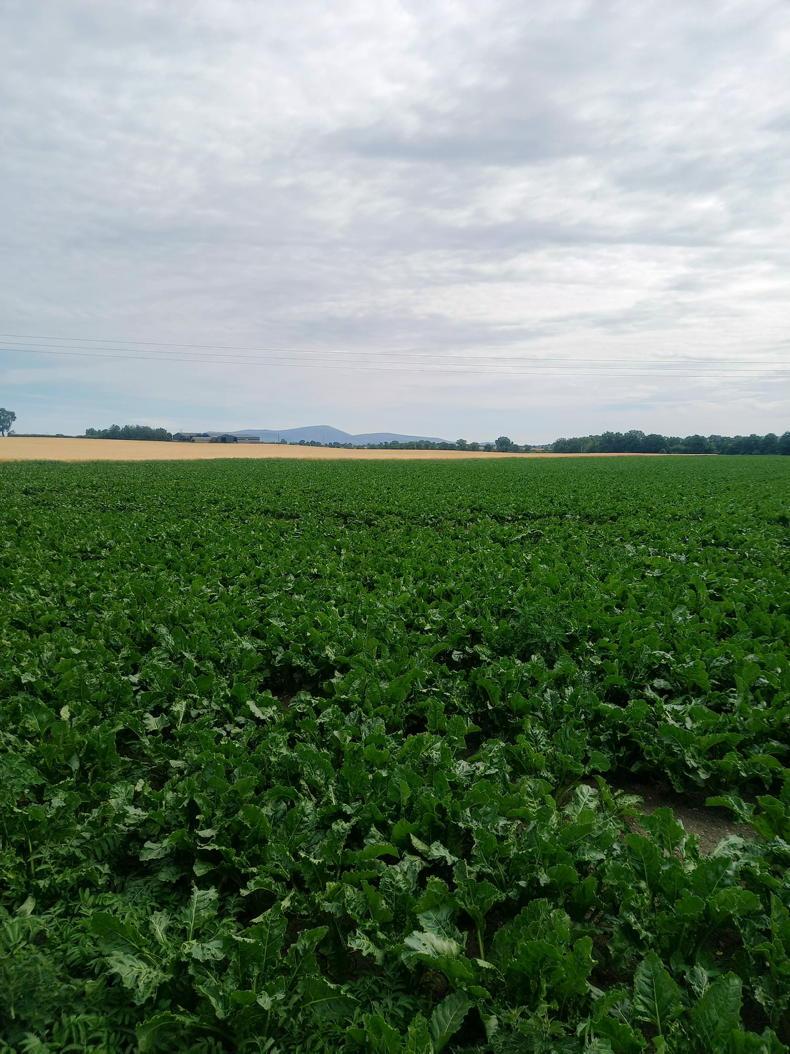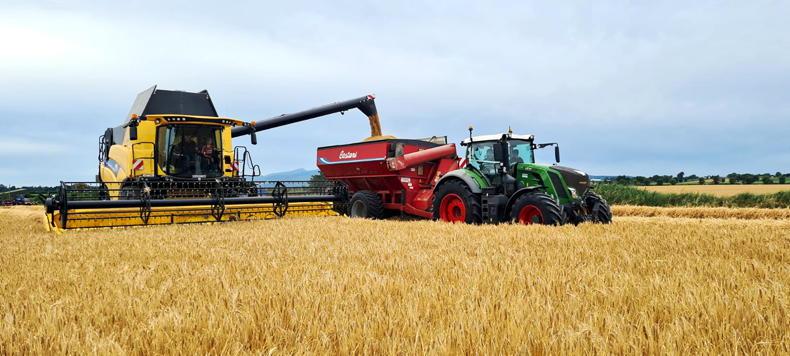James English has been busy cutting winter barley over the past week and hopes to get it wrapped up by Thursday. It will then be straight on to the winter oat crops.
Belfry and Bazooka are the winter barley varieties on the farm. Both are six-row hybrids and when we spoke on Monday, James was happy with their progress overall.
The first acres cut were on dry ground and the crop had suffered from this, coming in under 3.5t/ac. However, winter barley close to a break crop is performing well, going over 4t/ac.
Moisture is at 15% in much of the crop and KPH is coming in at 68-70, but the poorer barley cut first was in the low 60s for KPH.
Straw will be left for three to four days before baling into 8x4x4s and will be moved quickly, allowing James to get land cultivated. James stubble cultivates his land every year soon after harvest and this year is no different with the Vaderstad TopDown.
James noted that planting break crops is helping to improve crop performance and minimum tillage is helping to conserve soil moisture, which is showing in his crops.
Oilseed rape is the main break crop on the farm and this year, all of the oilseed rape being grown is High Erucic Acid Rape (HEAR) oilseed rape for Glanbia and carries a premium.
The rape is sprayed one week now and is expected to be ready for harvest in another week. It received a pod sticker along with glyphosate. It is coming in very fast in the hot weather. Before the rape comes in though, winter oats will be harvested.
The wheat is very green still. The disease control programme has kept Septoria at bay and the crop looks well.
George Byrne was planning on cutting winter barley in Co Carlow on Wednesday. Many of his crops are for seed and the Department was doing final inspections this week.
His winter barley is a six-row hybrid – Belfry – and the disease programme has kept the crop clean. The cool weather of recent weeks has been ideal and it is clear that crops after maize and beet have taken up plenty of nitrogen from the soil. He is looking forward to seeing the yield results.
Straw on the winter barley is slightly green and it will need to be left down for a few days. George is chopping some of his winter barley straw. He has plenty of straw sold and is happy that he has enough straw down for chopping.

George Byrne's beet looking well in Co Carlow.
George is well set up for stubble cultivation rules. He will use a disc and is confident of getting it completed in the given time frame.
In the spring barley fields, temperatures are good for grain fill and rain a few weeks ago was important to keep crops green. Disease control programmes have worked well and crops are clean. Winter wheat is holding its green colour well and is a month or so away from harvest.
The Alisha beet looks really well. Some of the crop was attacked by mangold fly. The late sown beet is looking very well. Grass weeds were sprayed with Stratos Ultra, while the crop has received two applications of trace elements and boron.
There is some seedy beet in the early-sown crops and this will be rogued.
The gate is now closed on George’s beans. They received a second fungicide in the shape of Signum at 0.7kg/ha and Nutriphite at 1l/ha. The crop is tall with plenty of pods and is still in flower.
Away from the tillage fields, George has cut a second cut of silage and applied slurry on that land.
He will get a third-cut from this crop before it is ploughed for winter wheat in the autumn time.
Shane Nolan expects to be cutting winter barley next week. The Clare man is a contractor and finished up first-cut silage at the beginning of this week. The winter barley will hopefully fit in nicely before second-cut silage begins.
Shane is happy with the crop. It’s ripening quickly at the minute, although crows are a problem.
Shane’s combine is fresh enough so there isn’t much work to be done to it before harvest, but he will need to make some adjustments to trailers, which were being used for silage.
He will most likely keep the grain in the shed for a while as the price has dropped. Some farmers will purchase barley from Shane out of the field.
Shane is frustrated at the lack of interest in Irish grain when prices are high and says Irish grain needs to be supported.
He has markets for straw and will not chop any on the farm. The spring barley harvest is most likely more than a month away. It is starting to turn at the minute and the spray programme has worked well.
Beet
In the beet fields, rain is needed. Shane said his beet crop is not fully closed in the rows.
It received nitrogen with sulphur a few weeks ago, but what it needs most is moisture.
One shower fell on Monday night this week but it did not have much of an impact on soil moisture levels.
It was a dull day on Tuesday, but there was plenty of work happening in fields around him, with some farmers making hay. He has noticed that other crops in the area are not as badly off for rain.
Boron was applied to the crop earlier in the season and weeds are now under control. The crop will be watched for disease in the coming weeks.
James English has been busy cutting winter barley over the past week and hopes to get it wrapped up by Thursday. It will then be straight on to the winter oat crops.
Belfry and Bazooka are the winter barley varieties on the farm. Both are six-row hybrids and when we spoke on Monday, James was happy with their progress overall.
The first acres cut were on dry ground and the crop had suffered from this, coming in under 3.5t/ac. However, winter barley close to a break crop is performing well, going over 4t/ac.
Moisture is at 15% in much of the crop and KPH is coming in at 68-70, but the poorer barley cut first was in the low 60s for KPH.
Straw will be left for three to four days before baling into 8x4x4s and will be moved quickly, allowing James to get land cultivated. James stubble cultivates his land every year soon after harvest and this year is no different with the Vaderstad TopDown.
James noted that planting break crops is helping to improve crop performance and minimum tillage is helping to conserve soil moisture, which is showing in his crops.
Oilseed rape is the main break crop on the farm and this year, all of the oilseed rape being grown is High Erucic Acid Rape (HEAR) oilseed rape for Glanbia and carries a premium.
The rape is sprayed one week now and is expected to be ready for harvest in another week. It received a pod sticker along with glyphosate. It is coming in very fast in the hot weather. Before the rape comes in though, winter oats will be harvested.
The wheat is very green still. The disease control programme has kept Septoria at bay and the crop looks well.
George Byrne was planning on cutting winter barley in Co Carlow on Wednesday. Many of his crops are for seed and the Department was doing final inspections this week.
His winter barley is a six-row hybrid – Belfry – and the disease programme has kept the crop clean. The cool weather of recent weeks has been ideal and it is clear that crops after maize and beet have taken up plenty of nitrogen from the soil. He is looking forward to seeing the yield results.
Straw on the winter barley is slightly green and it will need to be left down for a few days. George is chopping some of his winter barley straw. He has plenty of straw sold and is happy that he has enough straw down for chopping.

George Byrne's beet looking well in Co Carlow.
George is well set up for stubble cultivation rules. He will use a disc and is confident of getting it completed in the given time frame.
In the spring barley fields, temperatures are good for grain fill and rain a few weeks ago was important to keep crops green. Disease control programmes have worked well and crops are clean. Winter wheat is holding its green colour well and is a month or so away from harvest.
The Alisha beet looks really well. Some of the crop was attacked by mangold fly. The late sown beet is looking very well. Grass weeds were sprayed with Stratos Ultra, while the crop has received two applications of trace elements and boron.
There is some seedy beet in the early-sown crops and this will be rogued.
The gate is now closed on George’s beans. They received a second fungicide in the shape of Signum at 0.7kg/ha and Nutriphite at 1l/ha. The crop is tall with plenty of pods and is still in flower.
Away from the tillage fields, George has cut a second cut of silage and applied slurry on that land.
He will get a third-cut from this crop before it is ploughed for winter wheat in the autumn time.
Shane Nolan expects to be cutting winter barley next week. The Clare man is a contractor and finished up first-cut silage at the beginning of this week. The winter barley will hopefully fit in nicely before second-cut silage begins.
Shane is happy with the crop. It’s ripening quickly at the minute, although crows are a problem.
Shane’s combine is fresh enough so there isn’t much work to be done to it before harvest, but he will need to make some adjustments to trailers, which were being used for silage.
He will most likely keep the grain in the shed for a while as the price has dropped. Some farmers will purchase barley from Shane out of the field.
Shane is frustrated at the lack of interest in Irish grain when prices are high and says Irish grain needs to be supported.
He has markets for straw and will not chop any on the farm. The spring barley harvest is most likely more than a month away. It is starting to turn at the minute and the spray programme has worked well.
Beet
In the beet fields, rain is needed. Shane said his beet crop is not fully closed in the rows.
It received nitrogen with sulphur a few weeks ago, but what it needs most is moisture.
One shower fell on Monday night this week but it did not have much of an impact on soil moisture levels.
It was a dull day on Tuesday, but there was plenty of work happening in fields around him, with some farmers making hay. He has noticed that other crops in the area are not as badly off for rain.
Boron was applied to the crop earlier in the season and weeds are now under control. The crop will be watched for disease in the coming weeks.







 This is a subscriber-only article
This is a subscriber-only article











SHARING OPTIONS: